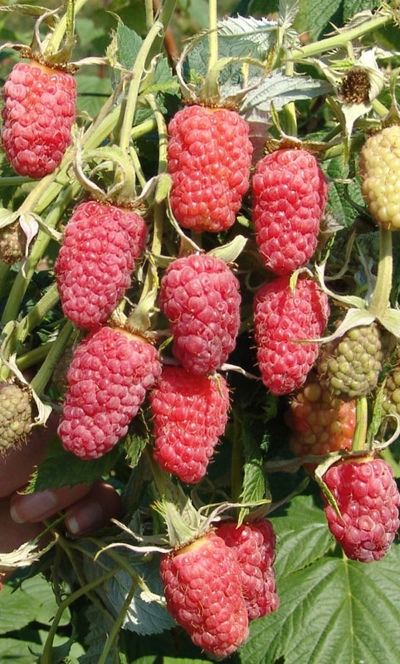
- Authors: State Scientific Institution All-Russian Institute of Selection and Technology of Horticulture and Nursery of the Russian Agricultural Academy
- Berry color: purplish red
- Taste: sweet
- Ripening period: average
- Berry weight, g: 8-15
- Yield: 6-10 kg per bush
- Frost resistance: winter hardy
- Appointment: for fresh consumption and homemade preparations
- Fruiting period: from 8-10 July
- Keeping quality: No
Raspberries are a useful and beloved berry that grows in almost every summer cottage. The greatest demand among amateur summer residents is for high-yielding varieties that are not too demanding on care and temperature extremes. One of these is a relatively young variety called Terenty.
Breeding history of the variety
Raspberry Terenty appeared thanks to the many years of efforts of domestic breeders in 1998. The variety was bred as a result of cross-pollination of two species - Tarusa and Patricia. Then the plant acquired its name and began to be studied and grown.
Description of the variety
Raspberry Terenty is a plant that resembles a mini-tree without thorns with thick stems, large leaves and bright weighty berries.
Ripening terms
The fruiting period lasts approximately 4-5 weeks. The first berries appear in the middle of summer and ripen before the beginning of autumn. Sometimes this period is shifted due to the climatic features of the region. Ripening of berries occurs evenly, which is very important when it comes time to harvest.
Growing regions
The optimal region for growing and breeding this variety is considered to be an area with moderate frosts and light snowfalls. In regions with winter temperatures below -30 degrees, raspberry bushes require high-quality insulation. Planting is possible both in the autumn and in the spring, that is, it is the end of March - the beginning of May.
Yield
The level of the yield and the correct development of the plant depends on how the bushes are planted on the site, as well as on the observance of the rules of care. The average large-fruited berry is 6 kg per bush. With favorable weather conditions and regular feeding of the plant, fertility can significantly increase up to 10 kg.
Berries and their taste
The berry of this raspberry is a large cone-shaped fruit of bright color with gloss. The weight of each berry is 8-10 grams, however, in the lower part of the bush, they can be slightly larger, reaching a weight of 12-15 g. The raspberry acquires sweetness when fully ripe, and the aroma is heard even in unripe fruits. Raspberry Terenty is quite fleshy, but with a low density, which practically excludes its transportation, so it can be consumed fresh or canned immediately, cook compotes, jelly.

Growing features
Site selection and soil preparation
Planting the plant should be in a sunlit area, where there are no drafts and strong winds. The best place is loamy soil, which retains moisture well. In one area, raspberry bushes can grow and bear fruit for up to 10 years. Planting should be carried out in such a way that the bushes on the north side are protected from the wind.


Pruning
Plants are pruned regularly, removing damaged, deformed, sprouted shoots. Trimming is carried out using a double method. A good bush is 8-10 shoots. Shortening is carried out in spring and autumn. The cut branches must be burned to avoid the spread of various plant diseases.

Watering and feeding
Raspberry Terenty does not tolerate extreme heat and moisture deficiency very well, so the balance needs to be adjusted on your own. In late spring, each bush is watered abundantly (3 liters per plant), and in summer - twice a month (6 liters per raspberry bush). In addition, abundant watering of the raspberry tree is carried out in the fall, which will help the plant to endure the winter.
Feeding with mineral and organic fertilizers occurs in spring and summer. In autumn, after digging, humus and wood ash are introduced.


Frost resistance and preparation for winter
This variety has moderate frost resistance, so the plant should be prepared for winter. It is recommended to dig the branches slightly into the ground, then cover with agrofibre.

Diseases and pests
Raspberries have good immunity to various infections and pests. As a preventive measure, the plant is sprayed three times a year - in early spring, during the flowering period and in late autumn.

Unfortunately, raspberries, like other plants, do not bypass various diseases and pests. Only armed with the knowledge and the necessary means for this, you can cope with such troubles. To help the plant, it is very important to be able to recognize the disease in time and begin timely treatment.
Reproduction
The main breeding method is the separation of the root growth and planting it in another place. If a bush grows slowly, it is recommended to try propagation by root cuttings or green shoots.

Review overview
By analyzing the many reviews, certain conclusions can be drawn. The Terenty variety is very tasty, aromatic, ideal for fresh eating and canning, but not profitable for growing on an industrial scale due to the impossibility of transportation. In addition, according to gardeners and summer residents, raspberries have good yields, as well as not very high requirements for care. Of the shortcomings, it is worth highlighting the too soft structure of the berry, which quickly deforms and deteriorates.







































































